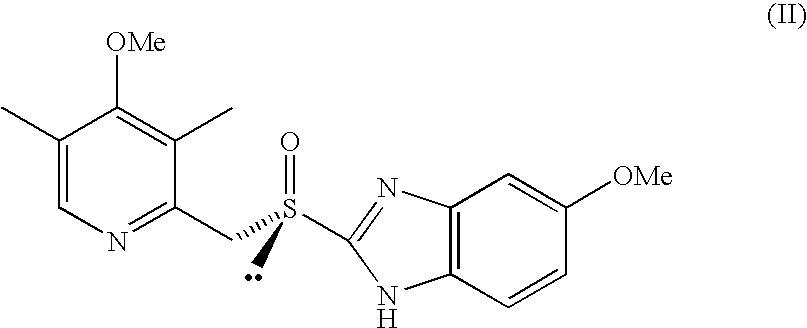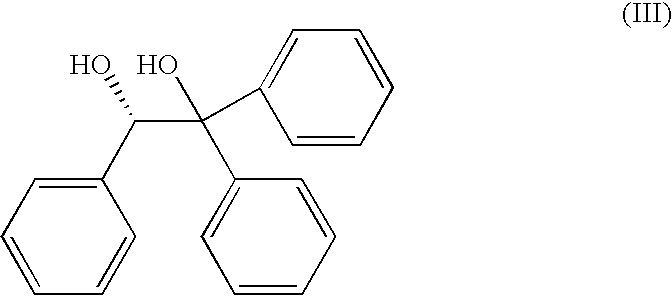Process for the Preparation of the (S)-Enantiomer of Omeprazole
a technology of omeprazole and enantiomer, which is applied in the field of process for the preparation of the (s)enantiomer of omeprazole, can solve the problems of difficult handling in large-scale production and further degradation, and achieve the effects of high enantiomeric purity, low price and high yield
- Summary
- Abstract
- Description
- Claims
- Application Information
AI Technical Summary
Benefits of technology
Problems solved by technology
Method used
Image
Examples
example 1
Preparation of (S)-omeprazole.2-[(S)-1,1,2-triphenyl-1,2-ethanediol] in toluene / heptane
[0040]A mixture of omeprazole (5 g, 14.5 mmol) and (S)-1,1,2-triphenyl-1,2-ethanediol (6.30 g, 21.7 mmol) was dissolved in a minimum of a toluene / heptane mixture (0.84:0.16, 190 ml) at 100° C. On dissolution, the solution was cooled to ambient temperature slowly with vigorous stirring, and on reaching this temperature was stirred for a further 1 h. The precipitate was filtered, was washed with a toluene / heptane mixture (3:1, 2×50 ml) and was dried in vacuo to afford (S)-omeprazole.2-[(S)-1,1,2-triphenyl-1,2-ethanediol] inclusion complex (6.108 g, 91%, 96.3% e.e.) as an off-white powder.
example 2
Preparation of (S)-omeprazole.2-[(S)-1,1,2-triphenyl-1,2-ethanediol] in toluene
[0041]A mixture of omeprazole (250 mg, 0.72 mmol) and (S)-1,1,2-triphenyl-1,2-ethanediol (315 mg, 1.08 mmol) was dissolved in a minimum volume of toluene (11 ml) at 90° C. On dissolution, the solution was cooled to ambient temperature slowly with vigorous stirring, and on reaching this temperature was stirred for a further 1 h. The precipitate was filtered, was washed with toluene (2×3 ml) and was dried in vacuo to afford (S)-omeprazole.2-[(S)-1,1,2-triphenyl-1,2-ethanediol] inclusion complex (291 mg, 87%, 95% e.e.) as an off-white powder.
example 3
Preparation of (S)-omeprazole.2-[(S)-1,1,2-triphenyl-1,2-ethanediol] in isopropyl alcohol
[0042]A mixture of omeprazole (250 mg, 0.72 mmol) and (S)-1,1,2-triphenyl-1,2-ethanediol (315 mg, 1.08 mmol) was dissolved in a minimum volume of isopropyl alcohol (10 ml) at reflux temperature. On dissolution, the solution was cooled to ambient temperature slowly with vigorous stirring, and on reaching this temperature was stirred for a further 1 h. The precipitate was filtered, was washed with isopropyl alcohol (2×2 ml) and was dried in vacuo to afford (S)-omeprazole.2-[(S)-1,1,2-triphenyl-1,2-ethanediol] inclusion complex (240 mg, 72%, 97% e.e.) as an off-white powder.
PUM
| Property | Measurement | Unit |
|---|---|---|
| temperatures | aaaaa | aaaaa |
| pH | aaaaa | aaaaa |
| temperature | aaaaa | aaaaa |
Abstract
Description
Claims
Application Information
 Login to View More
Login to View More - R&D
- Intellectual Property
- Life Sciences
- Materials
- Tech Scout
- Unparalleled Data Quality
- Higher Quality Content
- 60% Fewer Hallucinations
Browse by: Latest US Patents, China's latest patents, Technical Efficacy Thesaurus, Application Domain, Technology Topic, Popular Technical Reports.
© 2025 PatSnap. All rights reserved.Legal|Privacy policy|Modern Slavery Act Transparency Statement|Sitemap|About US| Contact US: help@patsnap.com



